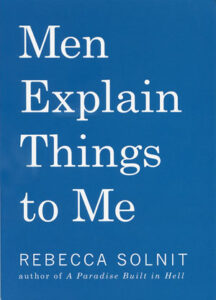In Rebecca Solnit’s latest book, seven essays lead us through what it means when half of the world’s population is silenced, ignored, and debased.
Men Explain Things to Me opens with Solnit’s essay of the same name, which recounts her experience at a dinner party where the host chatters on and on about a book, one which he has not read, and she in fact wrote. It takes several attempts by a friend until the host finally gets it. While this may seem like an innocuous story, it speaks to a larger societal issue—one in which women are silenced. This silencing has dark implications: in the U.S. a woman is raped every 6.2 minutes. And that only takes into account reported cases.
Throughout the book, Solnit is quick to point out that such instances do not apply to all men—many are even proud to call themselves feminists. And, as importantly, that she comes from a place of privilege, where her voice has been heard more loudly than the average woman. However she does see these misogynistic tendencies to be part of a national and global mentality—except that they are passed off as rare anomalies. She touches on the commonality of sexual assaults in the military, at work, throughout college campuses and most of all, in the home. One staggering statistic she points out is this: more women have been murdered as a result of domestic violence between 9/11 and 2012 than all of the victims of 9/11 and American soldiers killed during that time, combined.
Punctuating each section is a painting by artist Ana Teresa Fernandez. They are mysterious and symbolic, and complementary to the text. Preceding the essay “Worlds Collide in a Luxury Suite” we see a woman mid-stroke with a mop at the edge of the ocean. The chapter continues with Solnit’s keen use of Dominique Strauss-Kahn and Nafissatou Diallo as metaphors for the global north and south, and how that relates to colonization and globalization. In another, she explores the term “marriage equality” as well as how same-sex couples may inherently have more equal footing in their relationships. In “Woolf’s Darkness,” Solnit delves into the life and ideas of Virginia Woolf as well as Susan Sontag. Here, some of the paragraphs turn too abstract—a discussion of “Negative Capability” doesn’t seem to fit in the middle of the other essays. However I can understand the inclination to include words on Woolf, a woman who strode for empowered imagination and freedom.
At 124 pages, this collection is both an easy read and a difficult one. Easy because Solnit’s writing is so eloquently full of both grace and fury—not something many writers can pull off; difficult because of the storm of appalling facts. However it is definitely a book for both genders. As she points out, acts of silencing and sexual assault shouldn’t be framed as just a problem for women, but one that should be recognized and addressed by all.





